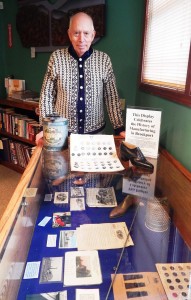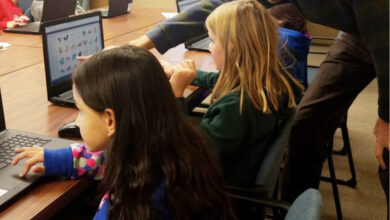Display cases inject historic roots into our daily routine

The expanding electronic media fills us with information and images of the present world. In a “now” culture, the past is easily neglected and historic roots become irrelevant. That is, until history pops into sight in the course of our daily lives. That is the strategy of the Brockport Community Museum Without Walls (MWW).
The Museum Without Walls has planted bits of local history in nine display cases in public places in the Brockport area. The display cases contain literature, photos, books, post cards, and real artifacts surviving more than 100 years of Brockport history (see photo). Six of the cases are table-style in oak and were made in the Brockport School District carpentry shop. Three ready-made cases were also contributed. Contents of the cases are provided by the Emily L. Knapp Museum and private individuals, and are detailed on the web site www.brockportcommunitymuseum.org. The cases are located at: Seymour Library, Chase Bank, Sweden Town Hall, Sweden Senior Center, Oliver Middle School, Hill School, Sweden/Clarkson Community Center, Dollinger’s Inn and Suites, and the Wal-Mart Super Center.
The display cases present an amazing variety of products, people and places from the past. Awe is mixed with appreciation for the early ingenuity and industry that have made present day Brockport rich in history with Landmark recognition.
There are also six historic interpretive panels placed around the Brockport area providing similar instant history lessons by MWW. The panels, measuring about two feet by three feet, provide photos and brief history on subjects like Brockport’s educational institutions, commerce, the canal and firefighting. The most recent panel was dedicated in Sagawa Park on October 19, featuring “Historic Churches in Downtown Brockport” (reported in the October 27, 2013 Suburban News and Hamlin-Clarkson Herald. See web site www.westsidenewsny.com.)
The “Museum Without Walls” concept was initiated by Bill Andrews, founding first president of the organization. The innovation was as an alternative to a defunct original plan for a stone-and-mortar Brockport Community Museum at 60 Clinton Street in Brockport. Feasibility studies in early 2000 gave estimates in the millions of dollars for restoration of the historic warehouse, plus $50,000 in annual operating expenses for a museum.
“The whole idea is that we go out into the community with our exhibits and interpretive signs, rather than getting people to come to us,” Andrews said about the practical alternative to a standing museum. “They are right out in the open where people are walking, staring them in the face.” In contrast to the daunting expense of a museum, “We literally have no budget,” he said. “We cost the taxpayers of the village nothing.”
The museum organization includes an Interior Display Committee for the display cases and Exterior Display Committee for interpretive panels. Interior Display Committee members are co-chairs Bill Andrews and Sean Bruno, George N. Dahl, Karlene VanDeusen and Douglas Wolcott. Exterior Display Committee members are current MWW president and committee chair, Allan Berry, plus George N. Dahl, Norman J. Frisch, Kory Hunsinger, and Karlene VanDeusen. Two other components of the MWW are the web site and ongoing interviews with local citizens eventually to preserve an oral history of Brockport on the web site.
Photo by Dianne Hickerson.


